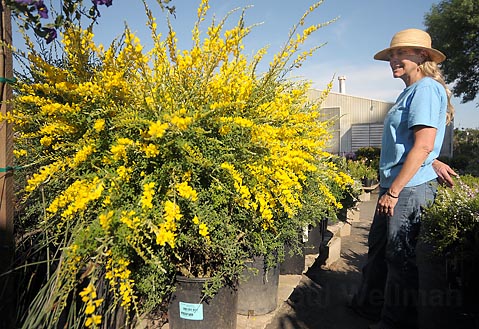Area Nurseries May Be Selling Invasive Plants
Little Shop of Horrors?

Many species of plants and animals call Santa Barbara County home. And though many human residents love the area for its scenic, natural backdrop, they may not realize that several species of plants-originally introduced for various gardening and ornamental purposes-react to the area’s unique climate and flora in a way that has prompted the Los Padres National Forest to list them as invasive. Some of the species presently causing more concern are French broom (Genista monspessulana), giant reed (Arundo donax), and fountain grass (Pennisetum setaceum). According to the Los Pardres National Forest officials and the California Invasive Plant Council (Cal-IPC), French broom and fountain grass are just beginning to spread along highway corridors and up along Highway 154. UCSB researchers say that giant reed, on the other hand, has become a major problem in waterways in the tri-county area, with dead reeds choking up river mouths and cluttering beaches.
“It’s a pretty solid idea in ecology to get things at the beginning of the invasion,” said Stephanie Yelenik, a UCSB PhD student studying invasive plant species. “We want people to know that we’re not being paranoid. It’s just very important to catch things early.” Tom Dudley, an associate research biologist with UCSB’s Marine Science Institute, said that once an invasion begins to take off, it’s difficult to ever catch up with it. “The fennel on Santa Cruz Island, for example, has been out there for years, and it’s very difficult to eradicate. It takes decades of work to eradicate a species that has taken over, because every seed is like an adult making babies.”
Carla D’Antonio, a professor with UCSB’s Department of Ecology, Evolution, and Marine Biology, maintains that 60 to 70 percent of the invasive plants seen in the wild come from the horticultural industry. “Most of the nurseries don’t want a bad reputation, but it’s difficult to [identify] things because [the nurseries] don’t use Latin names for these plants.” In other words, that flowery bush you buy at the local nursery could be an invasive plant. Then again, it might be a different, non-threatening species.
According to Cal-IPC, there are at least 1,200 non-native plant species that have established self-replacing populations in the wild, but there are only about 100 that are of concern. D’Antonio posits that the only real legal guidelines for what plant species a nursery can sell is the USDA’s list of “noxious” weeds. This list, however, deals only with agricultural applications. Plants in the wild are addressed by the U.S. Forest Service, the county, and Cal-IPC. “There has been a lot more dialogue between nurseries and groups like Cal-IPC,” she said.
One of the main concerns about the spread of invasive species is fire danger. The Forest Service Web site says of French broom that “its rapid growth leads to a rapid increase in fuel accumulation, greatly increasing the danger of fire.” The Los Padres National Forest knows that they have a developing problem with brooms,” said D’Antonio. “French broom is not widespread yet because it’s not good at penetrating dense chaparral, but after a fire, it gets into the burn area. The Forest Service doesn’t really have the personnel to handle removal.”
Yet many area nurseries have French broom or one of its close relatives available for sale. Fountain grass can be seen increasing in volume along highway corridors, but almost all area nurseries sell it. Giant reed is only available at a few nurseries, but it isn’t certain if it’s the species that costs the county so much money every year. “Is that stuff even legal?” queried one nursery employee when asked if they sold it. “Having biodiversity-having lots of options-is important,” said Yelenik. “It means that there’s more of a chance that if one species is wiped out by a pest or drought that it’s susceptible to, there will be others left.”


